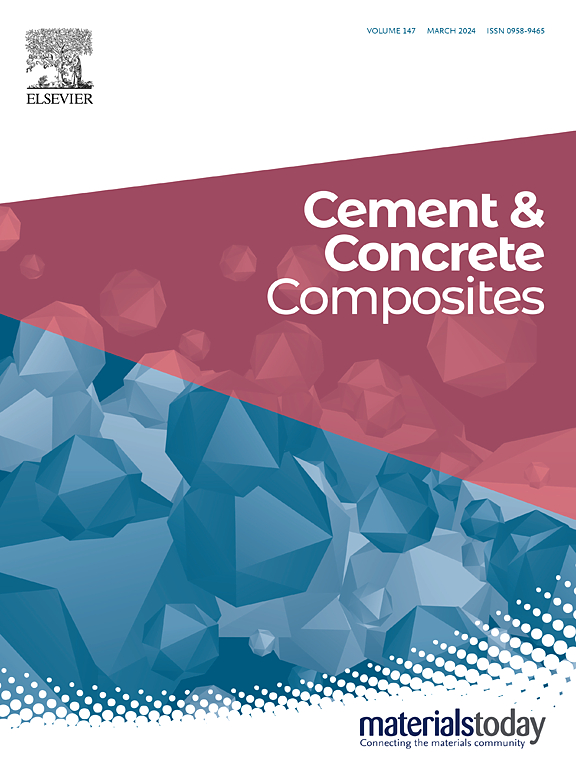Effect of in-situ alkali activator treatment of polypropylene fiber on the corrosion resistance of geopolymer coatings: test and mechanistic analysis
IF 13.1
1区 工程技术
Q1 CONSTRUCTION & BUILDING TECHNOLOGY
引用次数: 0
Abstract
This study addresses crack propagation-induced corrosion resistance degradation in geopolymers. Although economical polypropylene (PP) fibers demonstrate crack mitigation potential, their poor dispersion and weak interfacial bonding with the geopolymer matrix limit their performance. To overcome this issue, PP fibers were treated via an in-situ alkali activation process to form a surface-deposited inorganic layer that improved fiber dispersion and interfacial adhesion. A systematic evaluation of the fiber modification degree and dosage revealed that the optimal modified fiber content of 0.4 wt% (MPFGC0.4) resulted in substantial improvements versus unmodified counterparts: an 18.8 % increase in compressive strength, 8.1 % flexural strength enhancement, 42.5 % water absorption reduction, and a 67.8 % decrease in the chloride diffusion coefficient. The microstructural analysis confirmed that SiO44- species and inorganic groups on fiber surfaces optimize fiber dispersion and enhance bonding with the matrix. As a steel coating, the modified geopolymer exhibited the lowest mass loss ratio after salt-spray testing, with the profilometric analysis verifying improved fracture resistance. This work advances corrosion-resistant coating strategies for reinforced concrete in aggressive service environments.
聚丙烯纤维原位碱活化剂处理对地聚合物涂层耐腐蚀性能的影响:试验及机理分析
本研究针对地聚合物中裂纹扩展引起的耐蚀性退化。尽管经济型聚丙烯(PP)纤维具有减缓裂缝的潜力,但其分散性差和与地聚合物基体的界面结合弱限制了其性能。为了克服这一问题,通过原位碱活化工艺处理PP纤维,形成表面沉积的无机层,提高纤维的分散性和界面附着力。对纤维改性程度和用量的系统评价表明,与未改性的纤维相比,最佳改性纤维含量为0.4 wt% (MPFGC0.4)可显著改善纤维的抗压强度提高18.8%,抗折强度提高8.1%,吸水率降低42.5%,氯离子扩散系数降低67.8%。微观结构分析证实,纤维表面的SiO44-和无机基团优化了纤维的分散性,增强了纤维与基体的结合。作为一种钢涂层,改性地聚合物在盐雾测试中表现出最低的质量损失率,并通过轮廓分析验证了其抗断裂性能的提高。这项工作提出了在侵略性服务环境中钢筋混凝土的耐腐蚀涂层策略。
本文章由计算机程序翻译,如有差异,请以英文原文为准。
求助全文
约1分钟内获得全文
求助全文
来源期刊

Cement & concrete composites
工程技术-材料科学:复合
CiteScore
18.70
自引率
11.40%
发文量
459
审稿时长
65 days
期刊介绍:
Cement & concrete composites focuses on advancements in cement-concrete composite technology and the production, use, and performance of cement-based construction materials. It covers a wide range of materials, including fiber-reinforced composites, polymer composites, ferrocement, and those incorporating special aggregates or waste materials. Major themes include microstructure, material properties, testing, durability, mechanics, modeling, design, fabrication, and practical applications. The journal welcomes papers on structural behavior, field studies, repair and maintenance, serviceability, and sustainability. It aims to enhance understanding, provide a platform for unconventional materials, promote low-cost energy-saving materials, and bridge the gap between materials science, engineering, and construction. Special issues on emerging topics are also published to encourage collaboration between materials scientists, engineers, designers, and fabricators.
 求助内容:
求助内容: 应助结果提醒方式:
应助结果提醒方式:


